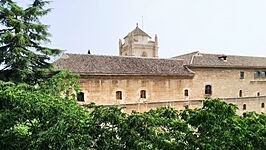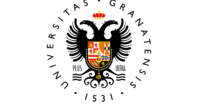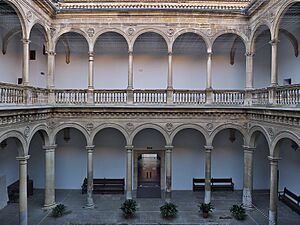University of Granada facts for kids
|
Universidad de Granada
|
|
 |
|
| Motto | Carolus Romanus Imperator Semper Augustus Hispaniae Rex Fundator Universitatis Granatensis, 1531 |
|---|---|
|
Motto in English
|
Charles I, Roman Emperor always Augustus, King of Spain and founder of the University of Granada, 1531 |
| Type | Public |
| Established | 1531 |
| Founder | Emperor Charles V |
| Endowment | €395,663,000 |
| Rector | Pedro Mercado Pacheco |
|
Administrative staff
|
3,400 |
| Students | 60,000 |
| Location | , , |
| Colours | Red |
| Affiliations | Coimbra Group, UNIMED |
| Website | www.ugr.es |
 |
|
The University of Granada (UGR) is a big public university in Granada, Spain. It was started in 1531 by Emperor Charles V. With over 60,000 students, it is one of the largest universities in Spain. Besides Granada, the UGR also has campuses in Ceuta and Melilla.
The university's Center for Modern Languages (CLM) welcomes more than 10,000 students from other countries every year. In 2014, students from around the world chose UGR as the best Spanish university. It is known for many subjects, from old languages to computer science. It is seen as one of the most important old universities in Europe.
Contents
History of the University of Granada
In 1526, a special school was opened in Granada. It was founded by Holy Roman Emperor Charles V. This school taught subjects like logic, philosophy, and law.
On July 14, 1531, a special permission was given by Pope Clement VII. This allowed a full university to be created. It would have departments for theology, arts, and law. This date marks the official start of the University of Granada. That is why its motto is "Universitas Granatensis 1531". The university's official seal shows the founder's coat of arms. It has the imperial double-headed eagle and symbols of Spanish kingdoms.
The main office of the University of Granada is in the Royal Hospital of Granada. This building also opened in 1526 during the time of Holy Roman Emperor Charles V. Today, it is a protected historical site in Spain.
The university has also added new, modern buildings. One example is the Granada Health Science Technological Park. This park has areas for teaching, healthcare, and research. It also helps new businesses grow.
University Rankings
| University rankings | |
|---|---|
| Global – Overall | |
| ARWU World | 201-300 (2023) |
| CWTS World | 261 (2023) |
| QS World | =401 (2026) |
| THE World | 601–800 (2023) |
| USNWR Global | 313 (2023) |
Universities are often ranked to show how good they are. The University of Granada is usually in the top five best Spanish universities. It is number one in studies like Translation and Interpreting. It is also a top leader in Computer Science Engineering in Spain. The UGR is also known for its scientific work. It ranks high nationally and is one of the best in the world for computing and math studies.
University Departments and Campuses
The UGR has 5 Schools, 22 Faculties, and 116 Departments. These are groups that teach and research specific subjects. They are spread across five different campuses in Granada. These campuses are called Centro, Cartuja, Fuentenueva, Aynadamar, and Ciencias de la Salud. There are also two more campuses in Ceuta and Melilla. These are Spanish cities in Northern Africa.
Campuses in Granada
- School of Building Engineering
- School of Architecture
- School of Civil Engineering
- School of Information Technology and Telecommunications
- Faculty of Fine Arts
- Faculty of Sciences
- Faculty of Sport Sciences
- Faculty of Economics and Business
- Faculty of Education
- Faculty of Political Science and Sociology
- Faculty of Health Sciences
- Faculty of Labour Studies
- Faculty of Communication and Documentation
- Faculty of Law
- Faculty of Pharmacy
- Faculty of Philosophy and Humanities
- Faculty of Medicine
- Faculty of Dentistry
- Faculty of Psychology
- Faculty of Social Work
- Faculty of Translation and Interpreting
Campus in Ceuta
- Faculty of Health Sciences
- Faculty of Education and Humanities
Campus in Melilla
- Faculty of Social Sciences
- Faculty of Education, Economy and Technology
- Faculty of Nursing
The University of Granada also offers many advanced study programs. These include Master's Degrees and Doctorate Programs. They follow the European model for learning.
School for Modern Languages
The UGR started welcoming students from other countries in 1992. This was when the School for Languages (Centro de Lenguas Modernas or CLM) was founded. By 2009–2010, about 5,000 international students were studying there. This included students from the Erasmus programme in the European Union. The CLM works with many universities and study abroad groups. These groups help bring students from North America to the UGR.
Famous People Who Studied Here
Many notable people have studied at the University of Granada. Here are a few:
- Francisco de Paula Martínez de la Rosa, a Spanish leader and writer.
- Julián Sanz del Río, a philosopher and educator.
- Pedro Antonio de Alarcón y Ariza, a writer and politician.
- Nicolás Salmerón y Alonso, a President of the First Spanish Republic.
- Manuel Gómez-Moreno Martínez, an archeologist and historian.
- Federico García Lorca, a famous Spanish writer.
- Frederick Forsyth, a British author.
- Joaquín Sabina, a famous poet, singer, and composer.
- Antonio Muñoz Molina, a writer.
- Pablo Heras-Casado, a Spanish music conductor.
- Andrés Neuman, a Spanish-Argentine writer.
- Gabriella Morreale de Escobar, a chemist and medical researcher.
- Ana M. Sanchez, a physicist and microscopy expert.
- Antonio Vidal-Puig, a medical doctor and scientist.
- Ariel Montalbán, a Spanish illustrator and comic artist.
See also
 In Spanish: Universidad de Granada para niños
In Spanish: Universidad de Granada para niños
- List of early modern universities in Europe


